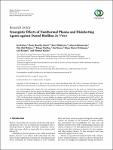Synergistic Effects of Nonthermal Plasma and Disinfecting Agents against Dental Biofilms In Vitro
Koban, Ina
Geisel, Marie Henrike
Holtfreter, Birte
Jablonowski, Lukasz
Hübner, Nils-Olaf
Matthes, Rutger
Masur, Kai
Weltmann, Klaus-Dieter
Kramer, Axel
Kocher, Thomas
Aim. Dental biofilms play a major role in the pathogenesis of many dental diseases. In this study, we evaluated the synergistic effect of atmospheric pressure plasma and different agents in dentistry on the reduction of biofilms. Methods and Results. We used monospecies (S. mutans) and multispecies dental biofilm models grown on titanium discs in vitro. After treatment with one of the agents, the biofilms were treated with plasma. Efficacy of treatment was determined by the number of colony forming units (CFU) and by live-dead staining. For S. mutans biofilms no colonies could be detected after treatment with NaOCl or H2O2. For multispecies biofilms the combination with plasma achieved a higher CFU reduction than each agent alone. We found an additive antimicrobial effect between argon plasma and agents irrespective of the treatment order with cultivation technique. For EDTA and octenidine, antimicrobial efficacy assessed by live-dead staining differed significantly between the two treatment orders (P < 0.05). Conclusions. The effective treatment of dental biofilms on titanium discs with atmospheric pressure plasma could be increased by adding agents in vitro.
No license information

